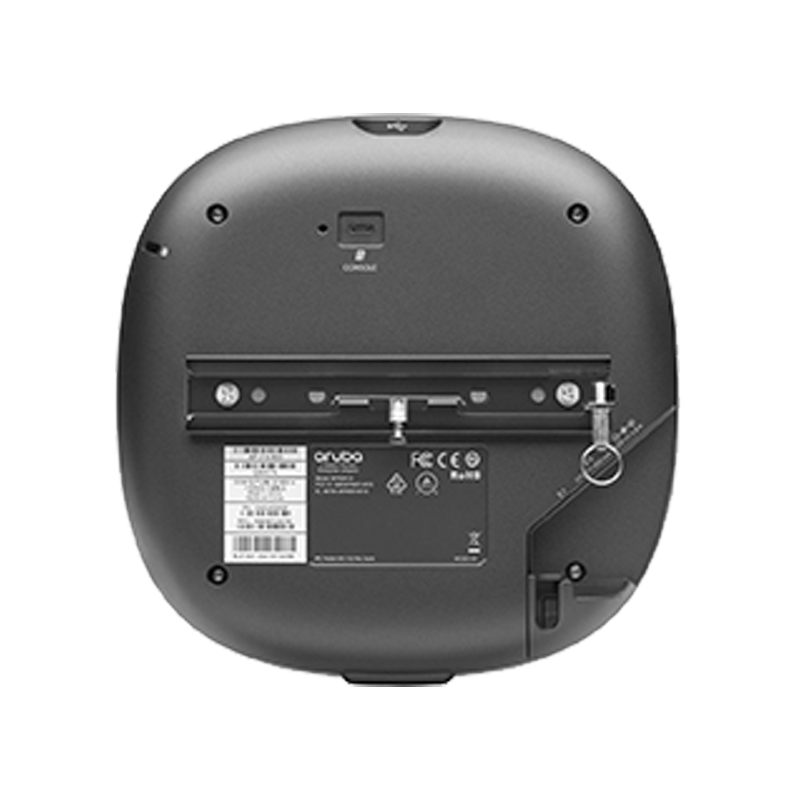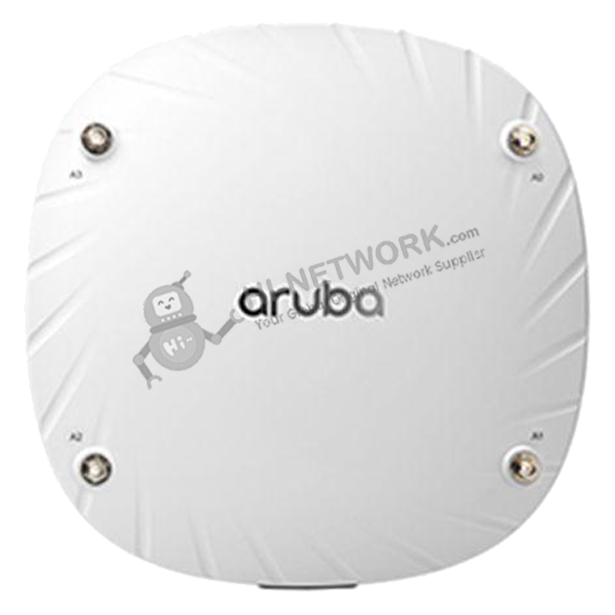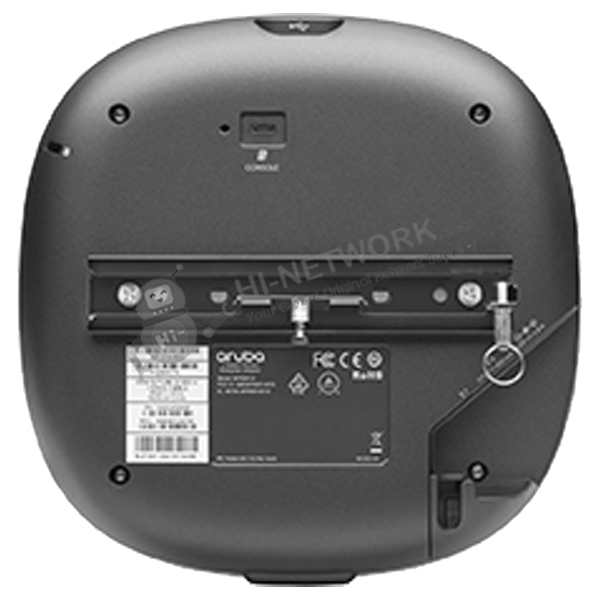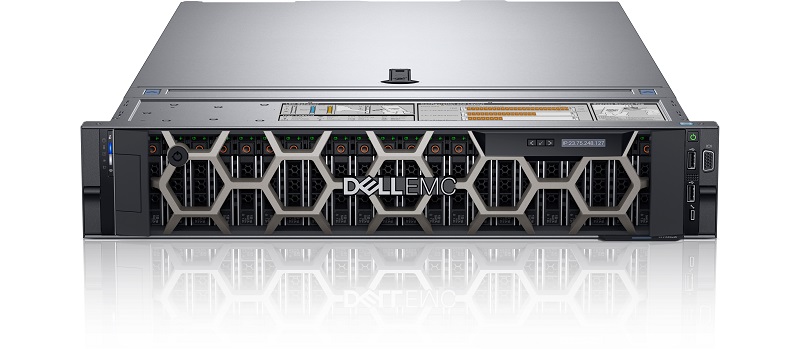





| Detail: | HPE Aruba Networking AP-514 (RW) Dual Radio 4x4:4 + 2x2:2 802.11ax External Antennas Unified Campus AP |
| Model: | Aruba AP-514 (RW) (Q9H57A) |
| Condition: | Factory Sealed New |
| Related: | |
| Warranty: |
 3 Years-Warranty
3 Years-Warranty
 100% Money-back
100% Money-back
 Free After-Sales Service
Free After-Sales Service
|
| Shipping: |
Air Shipping to
United States
, Most Customers Receive during 5-7 Days
?
If you finish the payment today,
your order will arrive within the estimated delivery time. |
| Ships to:
1.5
|
2-7 Days
US$
|
| Payment: |
More
|
The 510 series uses 802.11ax features to efficiently and simultaneously serve multiple clients and traffic types in dense environments, increasing data rates for both individual device and overall system.
Model | Q9H57A |
Series | Aruba AP-514 |
AP type | Indoor, dual radio, 5GHz 802.11ax 4x4 MIMO and 2.4 GHz 802.11ax 2x2 MIMO |
Description | HPE Aruba Networking AP-514 (RW) Dual Radio 4x4:4 + 2x2:2 802.11ax External Antennas Unified Campus AP |
Dimension (including single-gang wall box mount plate) | 200mm (W) x 200mm (D) x 46mm (H)/7.9” (W) x 7.9” (D) x 1.8” (H) |
Weight | 810g/28.5oz |
OperatingTemperature | 0°C to +50°C (32°F to +122°F) |
Storage Temperature | -40°C to +70°C (-40°F to +158°F) |
Humidity | 5% to 93% non-condensing |
Maximum number of BSSIDs | 16 BSSIDs per radio |
Supported frequency bands (country-specific restrictions apply) | ● 2.400 to 2.4835GHz ● 5.150 to 5.250GHz ● 5.250 to 5.350GHz ● 5.470 to 5.725GHz ● 5.725 to 5.850GHz ● 5.850 to 5.895GHz |
Antenna | ● Built in 90°H x 90°V Directional Antennas ● 5 GHz Antennas 5.6dBi ● 2.4 GHz Antennas 6.8dBi ● BLE/Zigbee: Integrated omnidirectional antennas with peak gain of 8.4dBi |
Maximum No. of associated client devices | Up to 512 associated client devices per radio |


● Up to 2.69 Gbps combined peak datarate
● WPA3 and Enhanced Open security
● Built-in technology that resolves sticky client issues for Wi-Fi 6 and Wi-Fi 5 devices
● OFDMA and MU-MIMO for enhanced multi-user efficiency
● IoT-ready Bluetooth 5 and Zigbee support
● Embedded ranging technology for accurate indoor location measurements
Aruba 510 Series Campus Access Points efficiently and simultaneously serve multiple clients, increasing data rates for both individual devices and as an overall system.
Multi-user transmission with downlink and uplink OFDMA increases user data rates and reduces latency, especially for large numbers of devices with short frames or low data-rate requirements, such as voice and IoT devices.
Multi-user capability with downlink multi-user MIMO improves network capacity by allowing multiple devices to transmit simultaneously.
As higher-performance 802.11ax access points drive more power consumption, the Aruba NetInsight GreenAP feature allows the 510 series access points to draw less power when it’s not being used, such as evenings when the buildings are empty.
Aruba ClientMatch technology in the Aruba 510 Series Campus Access Point will automatically attempt to group 802.11ax capable devices onto available AP radios with equivalent capabilities.
Performance benefits of Orthogonal Frequency Division Multiple Access (OFDMA) are maximized. This means increased network performance and a boost in network capacity.
The 510 Series uses ArubaOS 8 AirMatch (machine learning technology) to automatically optimize the performance of a wireless network by tuning the radio frequencies (RF) of the access points.
The access points run on ArubaOS 8, delivering always-on networking via features like LiveUpgrade, Controller Clustering, and seamless fail-over.
The Aruba 510 Series Campus Access Points helps make your network ready for the Internet of Things (IoT).
11ax technology provides unique benefits for IoT devices ranging from dedicated channels in OFDMA that allows for simultaneous transmission of IoT connections with low latency, to power saving options with Target Wake Time (TWT) to saves battery life.
The 510 series supports an integrated Bluetooth Low-Energy (BLE) and Zigbee radio, as well as a USB port for maximum flexibility, providing secure and reliable connectivity for IOT devices and for implementing location services.
Mount Kit | |
R3J18A | AP-MNT-D Campus AP mount bracket kit (individual) type D: solid surface |
R3J19A | AP-MNT-E Campus AP mount bracket kit (individual) type E: wall-box |
Power Adaptor | |
R3K00A | AP-AC2-12B 12V/48W AC/DC desktop style power adapter with 2.1/5.5mm connector |
External Antenna | |
JW009A | AP-ANT-1W 2.4-2.5GHz (4dBi)/4.9-5.875GHz (6dBi) Hi Gain Dual-band Omni-Dir Indoor Antenna |
Model | Q9H57A | Q9H62A |
Ports | (1) HPE SmartRate RJ-45 port (maximum negotiated speed 2.5Gbps), (1) 10/100/1000BASE-T Ethernet | (1) HPE SmartRate RJ-45 port (maximum negotiated speed 2.5Gbps), (1) 10/100/1000BASE-T Ethernet |
Power Consumption | POE powered (802.3at): 19W (802.3at PoE), 13.5W (802.3af PoE), 17 W (DC power supply) | POE powered (802.3at): 19W (802.3at PoE), 13.5W (802.3af PoE), 17 W (DC power supply) |
Wi-Fi antenna | Four RP-SMA connectors for external dual-band antennas. | Four integrated dual-band downtilt omni-directional antennas for 4x4 MIMO with peak antenna gain of 4.2dBi in 2.4GHz and 7.5dBi in 5GHz. |
Product Dimensions (imperial) | 1.8 x 7.9 x 7.9 in | 1.8 x 7.9 x 7.9 in |
Do you have any questions about the Q9H57A?
Contact us now via [email protected].
Specific Data Sheet:
Q9H57A Specification | |
Series | Aruba AP-514 |
AP type | Indoor, dual radio, 5GHz 802.11ax 4x4 MIMO and 2.4 GHz 802.11ax 2x2 MIMO |
Description | HPE Aruba Networking AP-514 (RW) Dual Radio 4x4:4 + 2x2:2 802.11ax External Antennas Unified Campus AP |
Dimension (excluding mount bracket) | 200mm (W) x 200mm (D) x 46mm (H)/7.9” (W) x 7.9” (D) x 1.8” (H) |
Weight | 810g/28.5oz |
OperatingTemperature | 0°C to +50°C (32°F to +122°F) |
Storage Temperature | -40°C to +70°C (-40°F to +158°F) |
Humidity | 5% to 93% non-condensing |
5GHz radio | ● Four spatial stream Single User (SU) MIMO for up to 4.8Gbps wireless data rate to individual 4SS HE160 802.11ax client devices (max) ● Two spatial stream Single User (SU) MIMO for up to 1.2Gbps wireless data rate to individual 2SS HE80 802.11ax client devices (typical) ● Four spatial stream Multi User (MU) MIMO for up to 4.8Gbps wireless data rate to up to four 1SS or two 2SS HE160 802.11ax DL-MU-MIMO capable client devices simultaneously (max) ● Four spatial stream Multi User (MU) MIMO for up to 2.4Gbps wireless data rate to up to four 1SS or two 2SS HE80 802.11ax DL-MU-MIMO capable client devices simultaneously (typical) |
2.4GHz radio | ● Two spatial stream Single User (SU) MIMO for up to 574Mbps wireless data rate to 2SS HE40 802.11ax client devices (max) ● Two spatial stream Single User (SU) MIMO for up to 287Mbps wireless data rate to 2SS HE20 802.11ax client devices (typical) |
Maximum number of BSSIDs | 16 BSSIDs per radio |
Supported frequency bands (country-specific restrictions apply) | ● 2.400 to 2.4835GHz ● 5.150 to 5.250GHz ● 5.250 to 5.350GHz ● 5.470 to 5.725GHz ● 5.725 to 5.850GHz ● 5.850 to 5.895GHz |
Available channels | Dependent on configured regulatory domain |
Supported radio technologies | ● 802.11b: Direct-sequence spread-spectrum (DSSS) ● 802.11a/g/n/ac: Orthogonal frequency-division multiplexing (OFDM) ● 802.11ax: Orthogonal frequency-division multiple access (OFDMA) with up to 16 resource units (RU) |
Supported modulation types | ● 802.11b: BPSK, QPSK, CCK ● 802.11a/g/n: BPSK, QPSK, 16-QAM, 64-QAM, 256-QAM (proprietary extension) ● 802.11ac: BPSK, QPSK, 16-QAM, 64-QAM, 256-QAM, 1024 QAM (proprietary extension) ● 802.11ax: BPSK, QPSK, 16-QAM, 64-QAM, 256-QAM, 1024 QAM |
Antenna | ● Built in 90°H x 90°V Directional Antennas ● 5 GHz Antennas 5.6dBi ● 2.4 GHz Antennas 6.8dBi ● BLE/Zigbee: Integrated omnidirectional antennas with peak gain of 8.4dBi |
Maximum No. of associated client devices | Up to 512 associated client devices per radio |
Supported data rates (Mbps) | ● 802.11b: 1, 2, 5.5, 11 ● 802.11a/g: 6, 9, 12, 18, 24, 36, 48, 54 ● 802.11n (2.4GHz): 6.5 to 300 (MCS0 to MCS15, HT20 to HT40) ● 802.11n (5GHz): 6.5 to 600 (MCS0 to MCS31, HT20 to HT40) ● 802.11ac: (5 GHz): 6.5 to 3,467 (MCS0 to MCS9, NSS = 1 to 4 for VHT20 to VHT160) ● 802.11ax (2.4GHz): 8.6 to 574 (MCS0 to MCS11, NSS = 1 to 2, HE20 to HE40) ● 802.11ax (5GHz): 8.6 to 4803 (MCS0 to MCS11, NSS = 1 to 4, HE20 to HE160) |
802.11n high-throughput (HT) support | HT 20/40 |
802.11ac very high throughput (VHT) support | VHT 20/40/80/160 |
802.11ax high efficiency (HE) support | HE 20/40/80/160 |
802.11n/ac packet aggregation | A-MPDU, A-MSDU |
Transmit power | Configurable in increments of 0.5 dBm |
Maximum (aggregate, conducted total) transmit power (limited by local regulatory requirements) | ● 2.4 GHz band: +22 dBm per chain, +25 dBm aggregate (2x2) ● 5 GHz band: +22 dBm per chain, +28 dBm aggregate (2x2) ● Note: conducted transmit power levels exclude antenna gain |
Certifications | ● CB Scheme Safety, cTUVus ● UL2043 plenum rating ● Wi-Fi Alliance certified 802.11a/b/g/n/ ● Wi-Fi Alliance certified Wi-Fi 6 (802.11ax) ● Wi-Fi CERTIFIED™ ac (with wave 2 features) ● Passpoint® (Release 2) with HPE Aruba Networking Operating System and Instant ● Wi-Fi CERTIFIED Location™ |
What is Guaranteed.
After receiving your order, take a full month to try it out. If you find quality is not good , we'll take it back and refund your money. Your complete satisfaction is GUARANTEED or your money back. That's guaranteed.
After your order items which are available. We will use most fast delivery way to global countries. Normally we will ship out cargos during 3 -5 days. And international delivery will take about 3- 10 days according to your location.
Service Never Ends.
Hardwares Warrany Time:
Original New Sealed Hardware: 3 Years
Refurbished/Used Original Devices: 1 Year
After warranty time, you also can contact us to return back for repair service. Everything you purchase from HI-NETWORK.COM. We will offer lifetime online service support for your any possible questions.

DELL Used R740 Rack Server

Huawei CloudEngine S5731-S24P4X: Powerful Enterprise-Grade Switch Explained

Huawei S5731-S48T4X Review: Powerful Enterprise Switch for High-Speed Networking

Why are network cables limited to 100 meters?

Huawei S5731-S32ST4X: Powerful, Enterprise-Ready Gigabit Switch with Advanced Capabilities

Huawei S5731-H48T4XC Review: High-Performance Switching for Modern IT Infrastructures

Huawei S5731-H48P4XC: Comprehensive Overview

Common display Commands for Huawei Devices

Stacking Card Stacking vs. Service Port Stacking: Application Scenarios for the Two Switch Stacking Methods
Connecting huawei switch console port configuration, there appear many ports forwarding data?